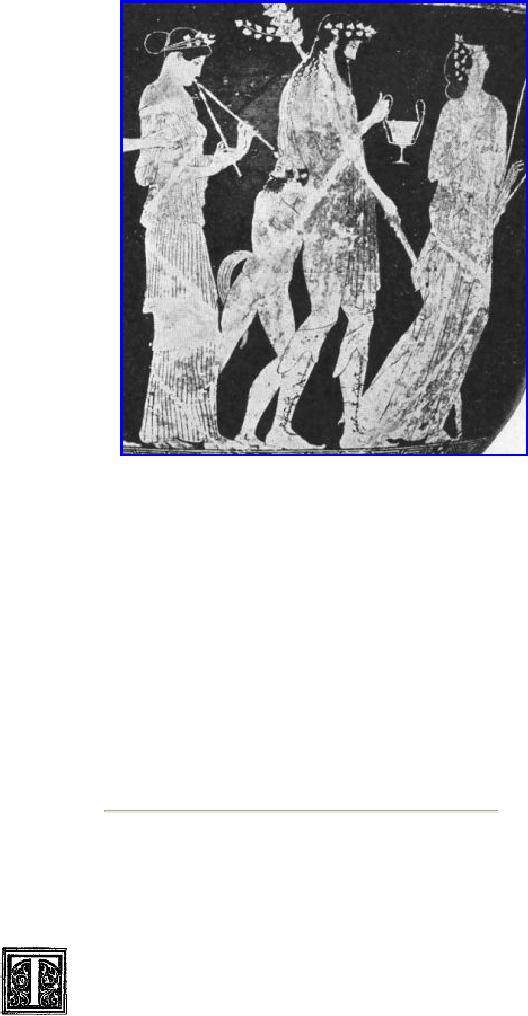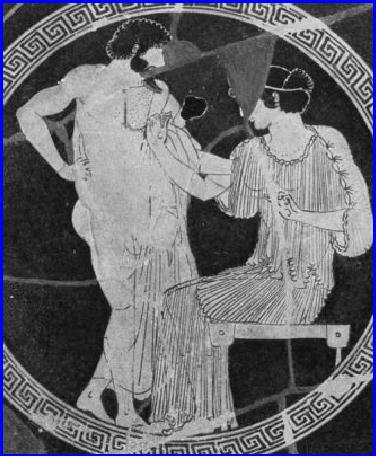 |
THE LAWS UNDERLYING ALL COSTUMING OF WOMAN |
| << A FEW HINTS FOR THE NOVICE WHO WOULD PLAN HER COSTUMES |
| HOW TO DRESS YOUR TYPE >> |

Metropolitan
Museum of Art Woman on Greek
Vase
The
only satisfactory copy of a
Fortuny tea gown we have
ever seen
accomplished
away
from the supervision of
Fortuny himself, was the
exquisite hand-work of a
young
American woman who lives in
New York, and makes
her own gowns and
hats,
because her interest and
talent happen to be in that direction.
She told a group
of
friends the other day, to
whom she was showing a
dainty chiffon gown, posed
on
a
form, that to her, the
planning and making of a lovely
costume had the same
thrilling
excitement that the painting
of a picture had for the
artist in the field
of
paint
and canvas. This same young
woman has worked constantly
since the
European
war began, both in London
and New York, on the
shapeless surgical
shirts
used by the wounded
soldiers. In this, does she
outrank her less
accomplished
sisters?
Yes, for the technique
she has achieved by making
her own costumes
makes
her swift and economical,
both in the cutting of her
material and in the
actual
sewing and she is invaluable as a
buyer of materials.
CHAPTER
II
THE
LAWS UNDERLYING ALL COSTUMING OF WOMAN
HAT
every
costume is either right or
wrong is not a matter of
general
knowledge.
"It will do," or "It is near enough" are
verdicts responsible
for
beauty hidden and interest
destroyed. Who has not
witnessed the mad

mental
confusion of women and men
put to it to decide upon costumes
for some
fancy-dress
ball, and the appalling
ignorance displayed when, at
the costumer's,
they
vaguely grope among battered-looking
garments, accepting those
proffered,
not
really knowing how the
costume they ask for
should look?
Absurd
mistakes in period costumes are to be
taken more or less
seriously
according
to temperament. But where is
the fair woman who will
say that a failure
to
emerge from a dressmaker's hands in a
successful costume is not a
tragedy? Yet
we
know that the average
woman, more often than
not, stands stupefied before
the
infinite
variety of materials and colours of
our twentieth century, and
unless guided
by
an expert, rarely presents
the figure, chez-elle,
or when on view in public
places,
which
she would or could, if in
possession of the few rules
underlying all
successful
dressing, whatever the century or
circumstances.
Six
salient points are to be
borne in mind when planning
a costume, whether for
a
fancy-dress
ball or to be worn as one goes
about one's daily
life:
First,
appropriateness to occasion, station and
age;
Second,
character of background you
are to appear against (your
setting);
Third,
what outline you wish to
present to observers (the period of
costume);
Fourth,
what materials of those in use
during period selected you
will choose;
Fifth,
what colours of those characteristic of
period you will use;
Sixth,
the distinction between those
details which are obvious
contributions to the
costume,
and those which are superfluous,
because meaningless or
line-destroying.
Let
us remind our reader that
the woman who dresses in
perfect taste often
spends
far
less money than she
who has contracted the
habit of indefiniteness as to
what
she
wants, what she should
want, and how to wear what
she gets.
Where
one woman has used her
mind and learned beyond all
wavering what she
can
and what she cannot wear,
thousands fill the streets by
day and places of
amusement
by night, who blithely carry
upon their persons costumes
which hide
their
good points and accentuate their bad
ones.
The
rara avis
among
women is she who always
presents a fashionable outline,
but
so
subtly adapted to her own
type that the impression
made is one of distinct
individuality.
One
knows very well how
little the average costume
counts in a theatre,
opera
house
or ball-room. It is a question of
background again. Also you will observe
that
the
costume which counts most
individually, is the one in a key
higher or lower
than
the average, as with a voice in a
crowded room.
The
chief contribution of our
day to the art of making
woman decorative is
the
quality
of appropriateness. I refer of course to the
woman who lives her
life in the
meshes
of civilisation. We have defined
the smart woman as she
who wears the
costume
best suited to each occasion
when that occasion presents
itself. Accepting
this
definition, we must all
agree that beyond question
the smartest women, as a
nation,
are English women, who
are so fundamentally convinced as to
the
invincible
law of appropriateness that from
the cradle to the grave,
with them
evening
means an evening gown;
country clothes are suited
to country uses and a
tea-gown
is not a bedroom neglig�e.
Not even in Rome can they be
prevailed upon
"to
do as the Romans do."
Apropos
of this we recall an experience in
Scotland. A house party had gathered
for
the
shooting,--English men and women.
Among the guests were
two Americans;
done
to a turn by Redfern. It really
turned out to be a tragedy, as
they saw it,
for
though
their cloth skirts were
short, they were silk-lined;
outing shirts were of
cr�pe--not
flannel; tan boots, but
thinly soled; hats most
chic, but the sort
that
drooped
in a mist. Well, those two
American girls had to choose
between long days
alone,
while the rest tramped the
moors, or to being togged out in
borrowed tweeds,
flannel
shirts and thick-soled
boots.
PLATE
IV
Greek
Kylix. Signed by Hieron, about
400
B.C.
Athenian. The woman wears
one of the
gowns
Fortuny (Paris) has
reproduced as a
modern
tea gown. It is in two
pieces. The
characteristic
short tunic reaches just
below
waist
line in front and hangs in long,
fine
pleats
(sometimes cascaded folds)
under the
arms,
the ends of which reach
below knees.
The
material is not cut to form
sleeves;
instead
two oblong pieces of
material are held
together
by small fastenings at short
intervals,
showing
upper arm through
intervening
spaces.
The result in appearance is
similar to
a
kimono sleeve. (Metropolitan
Museum.)

Metropolitan
Museum of Art Woman in
Greek
Art
about 400 B.C.
That
was some years back. We are a
match for England to-day, in
the open, but
have
a long way to go before we
wear with equal conviction,
and therefore easy
grace,
tea-gown and evening dress.
Both how
and
when
still
annoy us as a nation.
On
the street we are supreme when
tailleur.
In carriage attire the French
woman is
supreme,
by reason of that innate
Latin coquetry which makes
her feel
line
and its
significance.
The ideal pose for
any hat is a French
secret.
The
average woman is partially aware
that if she would be a
decorative being, she
must
grasp conclusively two
points: first, the
limitations of her natural
outline;
secondly,
a knowledge of how nearly
she can approach the outline
demanded by
fashion
without appearing a caricature, which is
another way of saying that
each
woman
should learn to recognise her
own type. The discussion of
silhouette has
become
a popular theme. In fact it
would be difficult to find a
maker of women's
costumes
so remote and unread as not to
have seized and imbedded deep in
her
vocabulary
that mystic word.
To
make our points clear,
constant reference to the stage is
necessary; for from
stage
effects we are one and all
free to enjoy and learn.
Nowhere else can the
woman
see so clearly presented the
value of having what she
wears harmonise with
the
room she wears it in, and
the occasion for which it is
worn.
Not
all plays depicting
contemporary life are plays
of social life, staged
and
costumed
in a chic manner. What is
taught by the modern stage,
as shown by Bakst,
Reinhardt,
Barker, Urban, Jones, the
Portmanteau Theatre and Washington
Square
Players,
is values,
as the artist uses the
term--not fashions; the
relative importance
Table of Contents:
- A FEW HINTS FOR THE NOVICE WHO WOULD PLAN HER COSTUMES
- THE LAWS UNDERLYING ALL COSTUMING OF WOMAN
- HOW TO DRESS YOUR TYPE
- THE PSYCHOLOGY OF CLOTHES
- ESTABLISH HABITS OF CARRIAGE WHICH CREATE GOOD LINE
- COLOUR IN WOMAN'S COSTUME
- FOOTWEAR
- JEWELRY AS DECORATION
- WOMAN DECORATIVE IN HER BOUDOIR
- WOMAN DECORATIVE IN HER SUN-ROOM
- I. WOMAN DECORATIVE IN HER GARDEN:WOMAN DECORATIVE ON THE LAWN
- WOMAN AS DECORATION WHEN SKATING
- WOMAN DECORATIVE IN HER MOTOR CAR
- HOW TO GO ABOUT PLANNING A PERIOD COSTUME
- I. THE STORY OF PERIOD COSTUMES:II. EGYPT AND ASSYRIA
- DEVELOPMENT OF GOTHIC COSTUME
- THE RENAISSANCE
- EIGHTEENTH CENTURY
- WOMAN IN THE VICTORIAN PERIOD
- SEX IN COSTUMING
- LINE AND COLOUR OF COSTUMES IN HUNGARY
- STUDYING LINE AND COLOUR IN RUSSIA
- MARK TWAIN'S LOVE OF COLOUR IN ALL COSTUMING
- THE ARTIST AND HIS COSTUME
- IDIOSYNCRASIES IN COSTUME
- NATIONALITY IN COSTUME
- MODELS
- WOMAN COSTUMED FOR HER WAR JOB
- IN CONCLUSION